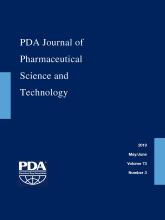Abstract
During the manufacture of a monoclonal antibody drug product, which was aseptically filled within a vapor phase hydrogen peroxide-sanitized isolator, samples were taken to investigate the hydrogen peroxide uptake behaviors. Surprisingly, the samples had no detectable hydrogen peroxide (most results below the limit of detection). This finding was later attributed to hydrogen peroxide decomposition after the samples were stored frozen at −20°C for two weeks before testing. This case study highlights the criticality of storage conditions for hydrogen peroxide-containing samples and summarizes an investigation on hydrogen peroxide stability in water and in three monoclonal antibody solutions having a wide protein concentration range (30–200 mg/mL). Samples were stored at three temperatures (−70°C, −20°C, or 2–8°C) for up to 28 days to assess the impact of protein concentration and storage temperature on hydrogen peroxide decomposition rates. Hydrogen peroxide degraded slightly more rapidly with increasing protein concentration independent of storage condition. When stored at −20°C, hydrogen peroxide was least stable and degraded faster than when stored at 2–8°C. Hydrogen peroxide was most stable when the samples were stored at −70°C. Overall, this case study brings the hydrogen peroxide stability issue to the attention of process development scientists and engineers and offers a valuable lesson learned during process development.
LAY ABSTRACT: The use of vapor phase hydrogen peroxide as a sanitizing agent for isolator and cleanroom decontamination has become common in recent years. Because of the potential impact of residual hydrogen peroxide on biopharmaceutical product quality, hydrogen peroxide uptake behaviors and mechanisms during the manufacturing process within these barriers need to be evaluated and understood. Samples taken from various small-scale and manufacturing-scale hydrogen peroxide uptake studies are often stored frozen before testing. This case study reports an important and interesting finding about hydrogen peroxide stability in samples collected for hydrogen peroxide uptake investigation, and it demonstrates the relationship between hydrogen peroxide stability and storage temperature, storage duration, and monoclonal antibody concentration. The approach and outcome of this study are expected to benefit scientists and engineers who develop biologic product manufacturing processes by providing a better understanding of drug product process challenges and appropriate sample storage.
- Hydrogen peroxide (H2O2)
- Vapor phase hydrogen peroxide (VPHP)
- Vaporized hydrogen peroxide (VHP)
- Monoclonal antibody
- VPHP uptake
- H2O2 decomposition
- © PDA, Inc. 2019
PDA members receive access to all articles published in the current year and previous volume year. Institutional subscribers received access to all content. Log in below to receive access to this article if you are either of these.
If you are neither or you are a PDA member trying to access an article outside of your membership license, then you must purchase access to this article (below). If you do not have a username or password for JPST, you will be required to create an account prior to purchasing.
Full issue PDFs are for PDA members only.
Note to pda.org users
The PDA and PDA bookstore websites (www.pda.org and www.pda.org/bookstore) are separate websites from the PDA JPST website. When you first join PDA, your initial UserID and Password are sent to HighWirePress to create your PDA JPST account. Subsequent UserrID and Password changes required at the PDA websites will not pass on to PDA JPST and vice versa. If you forget your PDA JPST UserID and/or Password, you can request help to retrieve UserID and reset Password below.






